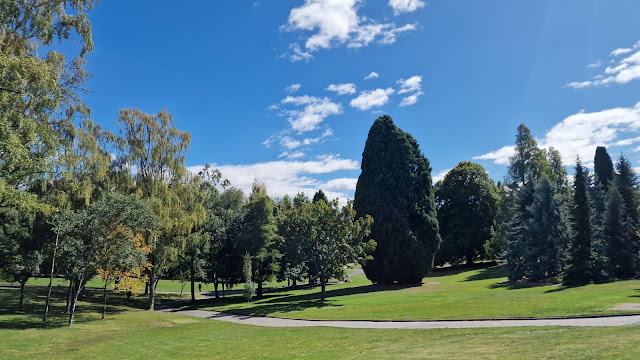We docked in Hobart around 11:00 am, and sat on the Pool Deck waiting to be called to go through the Australian Border Immigration. Unbeknown to us this had been taking place because there were no announcements on the pool deck. We were finally called and in hindsight we got through what could have been a laborious process very quickly. So it was back on board and time by the pool as we had a late tour, that would take us to the Bonorong Wildlife
Sanctuary.
Set outside Hobart, Bonorong is not a zoo, their aim to to help, protect and get healthy animals into the wild once again. As we arrived we were confronted by a herd of Grey Kangaroos and we were able to feed them and give them a good scratch.
I don't like photographing captive animals, but in this case it was an opportunity to capture images of animals you were never going to see in the wild, or in zoos in the United Kingdom. The first of those was the Echidna, an animal related to the Platypus, that lays eggs like them and seen as the earliest version of the mammal. They are extremely cute animals with a very long snout that houses an incredibly long tongue that it uses to suck up ants etc,
It was an evening visit and the sun was sinking behind clouds and Eucalyptus trees
In the trees around the sanctuary, our first Sulphur-crested Cockatoos and other wild birds.
And a Noisy Mynah, we were to see a lot of these.
Some more of the Cockatoos.
A beautiful Eastern Rosella.
The smaller Musk Lorikeet
There were Cape Barren Geese and Australian Wood Ducks.
One animal that nobody realises what it looks like is the Tasmanian Devil, portrayed as a fierce creature in reality they are about the size of a domestic cat. They feed mostly on carrion and will consume everything, having an incredibly strong bite
They have an extremely scary call, which is probably, along with their red ears gave the impression of a devil to the early European settlers.
We also had the chance to meet Quolls, a 10 month old Wombat, Tawny Frogmouths and Blue tailed Skinks. As the sun set we headed back to the ship for a late dinner.
We were still in Hobart the next day and we had the opportunity to go ashore and spend time in Hobart. It was a beautiful day as well which made it all the better.
We bought tickets for a round the city bus tour and headed to the Royal Botanical Gardens, a wonderful oasis in the north east of the city, immaculate gardens that gave us a taste of summer.
A mixture of Australian and New Zealand plants and trees with other countries like South Africa thrown in for good measure.
And views across the River Derwent.
It was great to see flowers and along with the flowers, butterflies, aside from the Monarch in Auckland we had not come across any up until now.
A Meadow Argus
Found mainly on the Australian Mainland it is also present in Tasmania. They are commonly found in urban areas, grassland and woodland.
It looks very much like a Small White and is known as a Small White.
Some birds now, a Little Wattlebird, which has expanded it's range in the last few decades, into urban gardens.
The Tasmanian Native-hen, a large flightless water hen. As they are flightless their means of escape is to run very fast. An endemic bird to Tasmania.
A Common Brown butterfly.
The Tasman Bridge across the mouth of the River Derwent.
We came across a group of female Superb Fairy Wrens along one of the paths. Unfortunately these were juvenile of female birds and there wasn't any sign of the male bird that gives it the name "superb".
They are constantly cocking their tail to an almost vertical position.
Another long tailed bird the Grey Fantail.
The Lily pad pond in the middle of the gardens.
And on the bank a Little Black Cormorant.
At first I dismissed these ducks as Mallard hybrids, then realised they were much different, the Pacific Duck.
Wonderful markings around the head and eye make them quite a striking duck, if maybe a little tame.
Waiting for the bus back into the city, there was a Yellow-throated Honeyeater, another endemic bird to Tasmania
We continued on the complete tour of Hobart, taking in the suburbs with some wonderful architecture and other places like the Female Factory, that was a part of the awful way the convicts were treated in Hobart in the 19th Century as the British established themselves.
I went up to the top deck to get a view of Hobart just before we left, Mount Wellington looms over the city.
Thoroughly enjoyed Hobart, one of those cities that has a calm and easy air about it, not rushed and hectic, with plenty of places and opportunities to enjoy the outside life.







































No comments:
Post a Comment